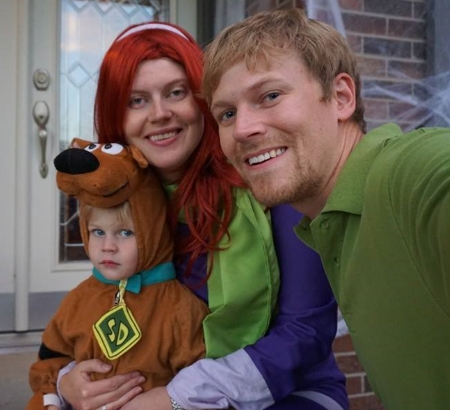A couple of weeks ago, we talked about Avatar: the Last Airbender and its excellent treatment of its characters. The larger, mobile one is now back on Scooby Doo, which was a favorite of his about two years ago, so much so that he dressed up as Scooby for Halloween.

(Cherish that picture. You will probably never get another.)
(Also, this was actually the third Halloween my husband and I spent as Shaggy and Daphne. Before we had offspring he had a stuffed Scooby that he used to wear on his shoulder like a pirate’s parrot.)
(Crazy things happen when dressed up as Shaggy and Daphne. The stories I could tell.)
(Also, my husband kind of looks like Shaggy in general, so much so that when we went to Universal Studios Hollywood for our first anniversary, the Shaggy and Scooby went right for him when they came out.)
(Anyway.)
Now, there are a million versions of Scooby Doo, and I realize that some versions treat character better than others, but in general, Scooby Doo is an exercise in stereotypes. And, funnily, the stereotypes vary from version to version, but pretty much all of them are unflattering to all involved.
Let’s go over them all in general terms shall we:
Fred: Fred is often portrayed as a dumb jock or as an airhead.
Daphne: Daphne is a pretty girl concerned mostly with shoes and clothes (and boys, in some versions).
Velma: Often the only one of the group with any brains, but also often portrayed as not attractive. Apparently completely blind without her glasses.
Shaggy: Dumb stoner obsessed with food.
Scooby: Scooby actually suffers from stereotypes less than the others. Is it because he’s the “lead” character? Because he’s a dog? A lot of times he gets stuffed into the same categories as Shaggy, but even then he tends to be more observant and occasionally find clues.
We’re not touching anyone else, because that’s madness.
And yet, the show has hung on for almost fifty years.
Now, of course, some of this is format. Scooby Doo, in most of its iterations, is episodic, and there’s only so much characterization you can stuff into a 20-minute episode. And, with such a large cast for such a short time, it makes sense to use stereotypes as people can readily identify them in the cultural norm.
Part of it may be the longevity of the characters at this point. If you did a new series and tried to give the characters arcs, would people accept that? The series that our library has, Mystery Incorporated, which ran from 2010 to 2013, tries to some extent, and, really, it’s all bad. That’s the choices they made, not necessarily an argument against giving the gang some characterization in general. (Like, do we really need to pair Velma and Shaggy up? And also we switch Velma’s normal stereotype for naggy girlfriend which is the worst.)
Would you agree with me that the characterization in the Scooby Doo shows is bad? Any thoughts on why or why not? Who’s your favorite member of the gang? (Mine’s Velma in most cases but Shaggy in some versions.)



